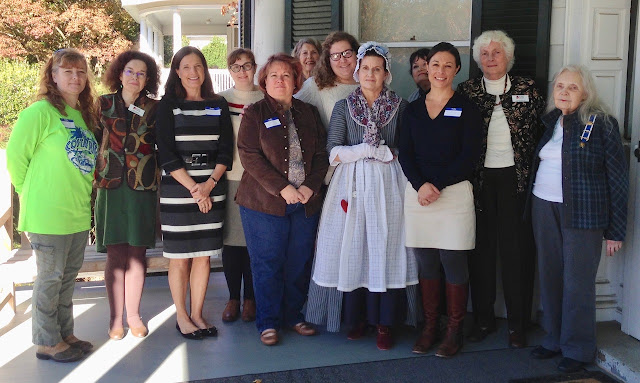To a sewist, there is nothing more wonderful than a well-drafted well-fitting pattern. I found this in the Larkin & Smith English gown pattern. I made some slight adjustments to the paper pattern and I was able to achieve a perfect fit. This gown is a stomacher front English gown with an en forreau back--representative of the early - mid 1770's. I'm wearing this gown in the photo below which was taken after a presentation about clothing during the last quarter of the 18th century given to the General Smallwood chapter of NSDAR.
I was so enamored with the fit of this pattern and the construction methods used that I decided to make my next center front closing gown using this same pattern. The construction methods are period correct and the method of pleating the en forreau back is fool proof. This conversion method will work with any stomacher gown pattern.
First I studied the differences between the two styles. The most obvious difference is that a center front close gown doesn't have a stomacher. It also doesn't have robings. So it appears that the main task will be to extend the front bodice to the center front plus a turn under allowance and the add a shoulder strap made from the fashion fabric. I settled on worsted wool for my fabric.
The first step requires a little bit of draping. Using Swedish tracing paper (sort of like a cloth) I first traced the front bodice piece and just extended the tracing paper an un determined amount to have some paper to work with when drawing the new lines. The piece on the left is the front bodice piece. The parallel lines are the edge and seam allowance on the original pattern piece edge. The pieces on the right are the original bodice front and lining.
Here is where a dress form comes in handy. Mine was being used so I hung my gown and pinned the stomacher in the way I would normally wear it. Then I pinned the new pattern piece to my gown at the side back seam, the parallel lines were pinned to the edge of the front piece and I pinned it at the center front of the stomacher. This did involve pinning the robing out of the way. I marked the center front and drew a line at the top of the stomacher so I'd have a rough idea as to where the neckline was.
I also made sure to mark the center front.
I redrew the neckline and bottom lines neatly and extended the front 3 inches past the center front line. The neckline looked a little high to me and I pinned the piece on myself in my stays and determined it was. I did end up lowering it about an inch.
I cut out the pattern piece and set about making a bodice muslin using the new pattern piece, the back lining piece and the shoulder strap. I tucked the seam allowance in along the neckline to check the depth. The front edges were folded in to achieve the correct fit. and pinned that hem in place before taking the muslin off.
The new bodice front was cut from the fashion fabric and the lining. I left the original pattern marks for the pocket slit and I made sure to mark where the skirt ended on the old stomacher gown to make sure it lined up the same way.
Basically I constructed this gown exactly the same as the pattern indicated for the stomacher gown. Here it is getting the skirt pleated to the bodice.
Once the skirt was sewn to the bodice, the lining shoulder strap was sewn on, the sleeve was attached and the back facing was stitched on as per pattern instructions.
Here is where things were a little different. At this point the robings would be sewn on. Instead, I cut shoulder straps from my fashion fabric, turned in the seam allowance on all sides and stitched them over the strap linings, encasing the sleeve seam.
Here is my first fitting. This is where I checked how much to turn in the front on each bodice piece. Each piece required a one inch turn in.
Here is the dress as first worn over a bound wool flannel petticoat with tambour embroidered accessories:
I'm really tickled with this gown. The fit is perfect and it's extremely comfortable. It may be my new favorite. I found this project to be a great learning experience and a nice intro to some basic draping. If you have this pattern, give it a try!











Lovely!!
ReplyDeleteReady to try this, thank you for the encouragement!
ReplyDeleteLOL at me. I would've never thought about using the stomacher to help me measure myself while converting a stomacher to a close front! I've been thinking about how to do it for ages and resigned myself with buying a new pattern for such a small tweak! Bookmarking this.
ReplyDelete